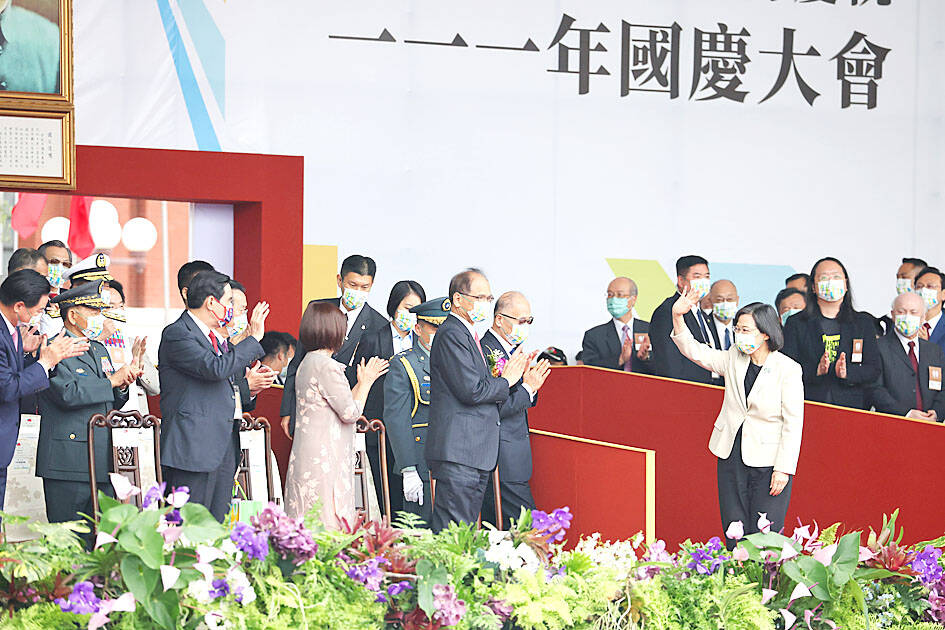President Tsai Ing-wen’s (蔡英文) remark that her administration is willing to work with Beijing to find a “mutually agreeable arrangement” to uphold peace and stability in the Taiwan Strait signals goodwill toward China, analysts said yesterday.
Tsai made the remark during her Double Ten National Day address on Monday.
Unlike last year’s address, in which Tsai said the Republic of China and the People’s Republic of China “should not be subordinate to each other,” her remarks this year seem to offer an olive branch to improve cross-strait stability, said Chu Chao-hsiang (曲兆祥), a professor at National Taiwan Normal University’s Graduate Institute of Political Science.

Photo: CNA
Beijing’s “one China” principle views Taiwan as part of its territory.
Cross-strait ties involve not only Taiwan and China, but also international factors, in particular the ties between Washington and Beijing, Chu said.
However, as Tsai’s address is expected to draw less ire from China, it can be considered, to some extent, to be an expression of goodwill, he added.
Chu praised Tsai, who is also chairperson of the Democratic Progressive Party (DPP), for her emphasis on Taiwan’s plan to reopen its borders to foreign arrivals.
Tsai said in her address that cross-strait armed confrontation is “absolutely not an option,” adding: “We look forward to the gradual resumption of healthy and orderly cross-strait people-to-people exchanges after the loosening of border restrictions on both sides, thereby easing tensions in the Taiwan Strait.”
“Provided there is rationality, equality and mutual respect, we are willing to work with the Beijing authorities to find a mutually agreeable arrangement to uphold peace and stability in the Taiwan Strait,” she said.
Chu said Tsai came up with concrete measures to boost cross-strait interactions following reopening, adding that they are expected to help Beijing and Taipei reduce tensions.
Tensions rose particularly following US House of Representatives Speaker Nancy Pelosi’s 19-hour visit to Taipei in early August, which prompted China to increase military exercises around Taiwan. Since then, Chinese military planes have repeatedly crossed the median line of the Taiwan Strait.
Chang Wu-ueh (張五岳), an associate professor at Tamkang University’s Graduate Institute of China Studies, said although he is not naive enough to think Tsai’s speech would lead to a significant improvement in cross-strait ties or mutual trust between Taipei and Beijing any time soon, the president’s tone was unlikely to spark anger from China or worsen ties even further.
Chang also said using the border reopening to reinforce cross-strait exchanges could calm tensions between Taipei and Beijing.
However, Shi Yinhong (時殷弘), a professor of international studies at Renmin University in Beijing, said Tsai’s mention of “Taiwan’s sovereignty” in her address amounts to “Taiwan independence,” to which China strongly opposes.
Shi said he does not think Tsai adopted a softer approach in her address, adding that the “1992 consensus” is the only foundation for cross-strait ties.
The so-called “1992 consensus” — a term that former Mainland Affairs Council chairman Su Chi (蘇起) in 2006 admitted making up in 2000 — refers to a tacit understanding between the Chinese Nationalist Party (KMT) and the Chinese Communist Party that both sides of the Taiwan Strait acknowledge that there is “one China,” with each side having its own interpretation of what “China” means.

Taiwanese scientists have engineered plants that can capture about 50 percent more carbon dioxide and produce more than twice as many seeds as unmodified plants, a breakthrough they hope could one day help mitigate global warming and grow more food staples such as rice. If applied to major food crops, the new system could cut carbon emissions and raise yields “without additional equipment or labor costs,” Academia Sinica researcher and lead author the study Lu Kuan-jen (呂冠箴) said. Academia Sinica president James Liao (廖俊智) said that as humans emit 9.6 billion tonnes of carbon dioxide compared with the 220 billion tonnes absorbed

The Taipei Mass Rapid Transit (MRT) Wanda-Zhonghe Line is 81.7 percent complete, with public opening targeted for the end of 2027, New Taipei City Mayor Hou You-yi (侯友宜) said today. Surrounding roads are to be open to the public by the end of next year, Hou said during an inspection of construction progress. The 9.5km line, featuring nine underground stations and one depot, is expected to connect Chiang Kai-shek Memorial Hall Station to Chukuang Station in New Taipei City’s Jhonghe District (中和). All 18 tunnels for the line are complete, while the main structures of the stations and depot are mostly finished, he

Taipei is to implement widespread road closures around Taipei 101 on Friday to make way for large crowds during the Double Ten National Day celebration, the Taipei Department of Transportation said. A four-minute fireworks display is to be launched from the skyscraper, along with a performance by 500 drones flying in formation above the nearby Nanshan A21 site, starting at 10pm. Vehicle restrictions would occur in phases, they said. From 5pm to 9pm, inner lanes of Songshou Road between Taipei City Hall and Taipei 101 are to be closed, with only the outer lanes remaining open. Between 9pm and 9:40pm, the section is

China’s plan to deploy a new hypersonic ballistic missile at a Chinese People’s Liberation Army Rocket Force (PLARF) base near Taiwan likely targets US airbases and ships in the western Pacific, but it would also present new threats to Taiwan, defense experts said. The New York Times — citing a US Department of Defense report from last year on China’s military power — on Monday reported in an article titled “The missiles threatening Taiwan” that China has stockpiled 3,500 missiles, 1.5 times more than four years earlier. Although it is unclear how many of those missiles were targeting Taiwan, the newspaper reported